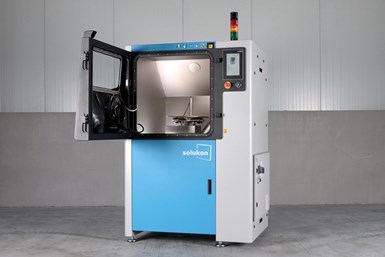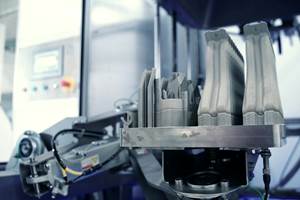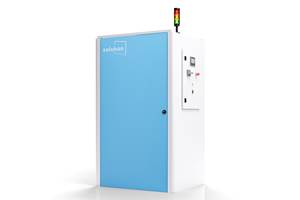Solukon Upgrades SFM-AT350 Depowdering System for Medium-Sized Parts
Formnext 2023: System upgrades include the addition of the SPR-Pathfinder depowdering software, a new form of excitation for depowdering delicate structures and new tracking options with the enhanced Digital Factory Tool.
Solukon has upgraded its SFM-AT350 depowdering system for medium-sized parts, making it even smarter and more transparent — and now cleans even more efficiently. Upgrades include the addition of the SPR-Pathfinder depowdering software, a new form of excitation for depowdering delicate structures and new tracking options with the enhanced Digital Factory Tool.
The system is intended for postprocessing medium-sized parts up to a height of 420 mm and a weight of 60 kg. The main features of the system include high freedom of motion, a compact structure with optimized chamber volumes and a minimal inertization time. Solukon is continuously developing and refining its systems to keep them prepared for all geometries. With three key upgrades, Solukon has now made the SFM-AT350 even stronger.
With the systems’s SPR-Pathfinder depowdering software, it is no longer necessary to program complex cleaning sequences for the SFM-AT350. Instead, they can be calculated quickly and easily with the SPR- Pathfinder software, which was initially designed just for the larger SFM-AT800-S and SFM-AT1000-S systems. Now it is available for the midrange segment. Based on the CAD file of the build job, the SPR-Pathfinder calculates the ideal motion sequence in the Solukon system for removing excess powder from complex interior structures.
The calculations of the software are based on a flow simulation that analyzes the part’s digital twin. The individually calculated motion sequence is then read by the Solukon system which, in turn, runs the programmed paths. This ensures that even the most complex parts with labyrinth-like channels are cleaned in record time and without any human programming effort.
“Smart, software-supported depowdering is also the key to serial cleaning with the SFM-AT350 and therefore, real serial production,” says Andreas Hartmann, Solukon CEO/CTO.
The system also offers a new form of excitation for delicate structures. In the future, Solukon will offer the depowdering system as the SFM-AT350-E with piezoelectric excitation. Users will have the choice between two completely different excitation forms — the familiar pneumatic form in conjunction with a vibrator and an optional knocker or the piezoelectric excitation. Both the piezoelectric excitation form (the SFM-AT350-E) and the SPR-Pathfinder are available as options for the SFM-AT350.
Because piezoelectric excitation originates directly at the rotary table of the Solukon system, the part can be shifted to the optimal vibration range with high precision. The high frequencies of the electronic excitation are considerably higher than the harmful natural frequency of the part. As the frequency constantly controls and regulates itself, the risk of exciting the resonance frequency and damaging sensitive structures is avoided.
Consequently, the SFM-AT350-E is well suited for depowdering delicate structures made from materials that are difficult to depowder, such as copper. Another advantage of the new form of excitation is its low levels of noise emission. As a result, the SFM-AT350-E is an appropriate fit for the naturally quiet 3D printer environment.
“The requirements for depowdering increase as part complexity, material complexity and diversity increase. Growing production quantities are also an influential factor,” Hartmann says. “At the same time, our customers want us to provide systems that are very easy to operate. After experiencing a breakthrough with the launch of our smart SPR-Pathfinder software, which calculates optimal part motion, we have achieved a further milestone upon launching the SFM-AT350-E. For any depowdering challenge, we can now offer the optimal frequency excitation.”
The system also features new tracking options with an enhanced Digital Factory Tool. Just like the SFM-AT800-S and SFM-AT1000-S, the SFM-AT350 and SFM-AT350-E are both available with an enhanced Digital Factory Tool (DFT).
- Read about Solukon’s metal powder collection unit which offers simple, safe material handling. With the SFM-PCU integrated into the additive manufacturing system, users no longer have direct contact with the powder material during depowdering — the powder remains in a closed system at all times.
- Here’s another Solukon postprocessing solution as the company expanded the compatibility of its unpacking and cleaning station for plastic parts. With adapters for EOS P 1 and P 5 series SLS manufacturing systems, the Solukon SFP770 postprocessing system can now accommodate build boxes from other leading printers, enabling Solukon to tap new markets in the area of polymer postprocessing.
- Learn about Solukon’s SPR-Pathfinder software for automatic depowdering. It is said the algorithm-based SPR-Pathfinder calculates the ideal motion sequence for the most complex geometries, finding the best path to enable the powder to flow out completely.
Related Content
Collaborators Developing Green Part Processing Solution for Cold Metal Fusion Technology
Formnext 2024: The AutoSmooth project was launched last year to develop a fully automated process chain for unpacking, depowdering and surface treatment of cold metal fusion parts.
Read MoreEnhanced Digital Factory Tool Quantifies Carbon Footprint of Automated Depowdering
Solukon has enhanced its Digital Factory Tool, which integrates additive manufacturing automation and quality assurance, giving the sensor and interface kit a more comprehensive transparency in automated depowdering.
Read MoreDepowdering Station Automatically Cleans Unused Metal Powder from 3D Printed Build Jobs
The Volkmann additive manufacturing technology is designed to safeguard workers from toxic materials and boost efficiency.
Read MoreSolukon’s Metal Powder Collection Unit Offers Simple, Safe Material Handling
With the SFM-PCU integrated into the additive manufacturing system, users no longer have direct contact with the powder material during depowdering — the powder remains in a closed system at all times.
Read MoreRead Next
3D Printed Polymer EOAT Increases Safety of Cobots
Contract manufacturer Anubis 3D applies polymer 3D printing processes to manufacture cobot tooling that is lightweight, smooth and safer for human interaction.
Read MoreCrushable Lattices: The Lightweight Structures That Will Protect an Interplanetary Payload
NASA uses laser powder bed fusion plus chemical etching to create the lattice forms engineered to keep Mars rocks safe during a crash landing on Earth.
Read MoreAlquist 3D Looks Toward a Carbon-Sequestering Future with 3D Printed Infrastructure
The Colorado startup aims to reduce the carbon footprint of new buildings, homes and city infrastructure with robotic 3D printing and a specialized geopolymer material.
Read More





















